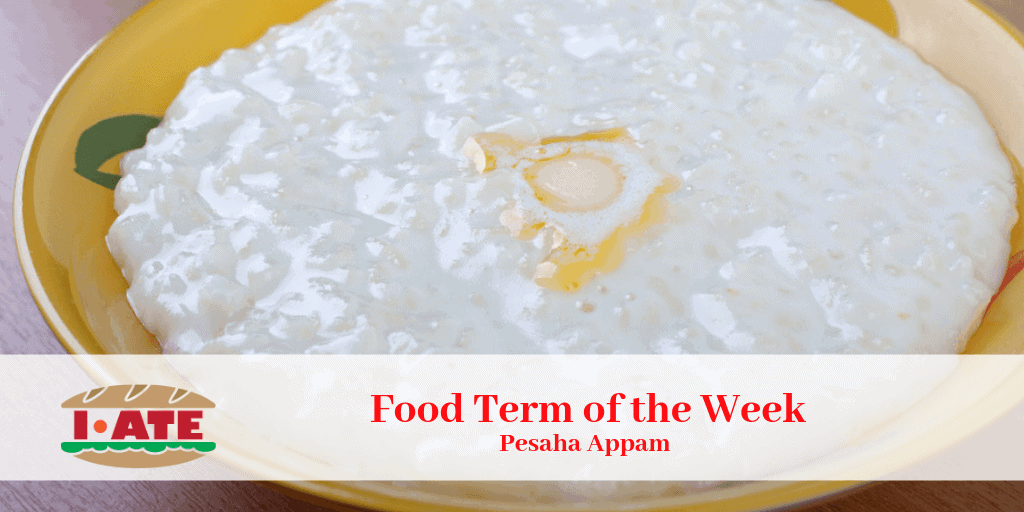
Pesaha Appam with Pesaha Paal for the celebration of Maundy Thursday
In traditional Christian Families of Kerala, India accustomed to celebrate both Jewish Passover and Holy Thursday where Jesus had his last supper with the Apostles. As part of this commemoration, the Christians of Kerala make Unleavened Passover bread that is called Pesaha Appam or Inriy Appam or Kuris Appam in their regional language called Malayalam. Linguistically the word Kuris means cross and Appam means Bread so it is also called Cross bread. Furthermore, the word Pesaha means Passover. Pesaha Appam is served with Paal a drink made with coconut milk, jaggery and some spices which is used instead of wine.
The unleavened bread or Pesaha Appam made on Maundy Thursday has several customary practices related to serving and preparation. One such mandatory practice include cleaning the kitchen and premises before cooking. Preparations start with prayer and in few places the head of the family (the oldest male member) prepares the cross bread. Furthermore, the cooking utensil used for cooking the Pesaha Appam should be a new one or may be dedicated only to making this dish every year. During the ancient times, earthenware pottery is used due to the unavailability of metal vessels to prepare the Pesaha meal. After the Pesaha meal preparation, the concerned pottery is smashed instantly. This is still practiced in some parts of Kerala. Finally, a tender coconut leaf blessed by a priest on Palm Sunday is used to make small cross-layed over this bread.
Pesaha Appam and Pesaha Paal preparation:
Pesaha Appam
Rice flour – 2 Cups
Urad (Whole) – 1 cup (soaked overnight in water)
Grated coconut – 1 1/2 cups
Salt – Salt1/2 tsp or as reqd
Red or small onion – 1 no ((blended)
Salt -1/2 tsp or as reqd
Preparation
1) Grind together rice flour, uzhunnu, coconut and salt to get a batter with good consistency
2) Take preferably steel plates of medium round shape
3) Pour batter in one and make a cross of palm leaf obtained on Palm Sunday on it.
4) Steam till well done in a new Kitchen vessel
Pesaha Paal (Paal means Milk)
Molasses – 400 gm (depends on the sweetness you need)
Rice flour -4-5-tbsp
Coconut milk – one can or milk from one fresh coconut
Cardamom – 5nos (powdered)
Preparation
1) Place molasses in a saucepan
2) Add some water and heat well
3) Allow it to boil. While boiling, a lather forms.
4) Strain the above liquid molasses
5) Mix together coconut milk and rice flour with cardamom powder and pour the mixture into melted molasses and stir continuously and until it becomes a thick sauce.
6) Make sure no lumps formed.
References
Joy R. Pesaha Appam. pachakam. https://pachakam.com/Recipes/Pesaha-Appam. Published April 21, 2019. Accessed June 12, 2019.
Pesaha of Mar Thoma Nasranis. http://www.nasranifoundation.org/articles/pesaha.html. Accessed June 12, 2019.
Sunny S. Pesaha Appam and pal, the toast of Holy Thursday. OnManorama. https://web.archive.org/web/20190417194702/https://food.manoramaonline.com/food/foodie/pesaha-appam-paal-maundy-thursday-special-unleavened-bread.html. Published April 13, 2017. Accessed June 12, 2019.
 Article written by Greeshma Johnson study visitor in Communication at the Terminology Coordination Unit of the European Parliament (Luxembourg) and student at the University of Luxembourg perusing the Master program in Learning and Communication in Multilingual and Multicultural Contexts. She graduated with a Bachelor of Arts in English Language and literature then obtained a Master of Arts in English Language and Literature. Competent Languages includes English, Malayalam, Hindi and Tamil. Currently learning French level A2 at Institut National des Langues.
Article written by Greeshma Johnson study visitor in Communication at the Terminology Coordination Unit of the European Parliament (Luxembourg) and student at the University of Luxembourg perusing the Master program in Learning and Communication in Multilingual and Multicultural Contexts. She graduated with a Bachelor of Arts in English Language and literature then obtained a Master of Arts in English Language and Literature. Competent Languages includes English, Malayalam, Hindi and Tamil. Currently learning French level A2 at Institut National des Langues.

